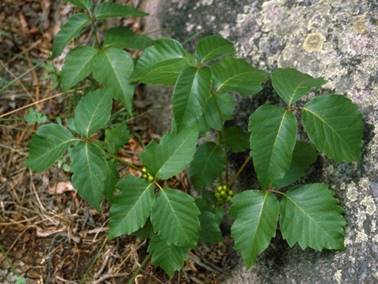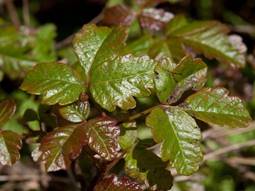
“I’ve often thought there ought to be a manual to hand to little kids, telling them what kind of planet they’re on, why they don’t fall off it, how much time they’ve probably got here, how to avoid poison ivy, and so on. I tried to write one once. It was called Welcome to Earth. —Kurt Vonnegut
Because of the obvious connection and because it’s time to get out on the trails, I’ve lumped these two together. They are both in the sumac genus and both contain irritating leaf oils that lead to skin reactions. Urushiol is a clear liquid compound in the plant’s sap and when it comes in contact with the skin causes dermatitis – an itchy rash. The level of discomfort varies with individuals, with some folks showing only minor effects while others break into a severe rash. People who have severe reaction to poison ivy or oak may also be allergic to the sap of mango trees as they are in the same plant family. Some folks are allergic to the pollen and can get a reaction just from being downwind when the flowers are in bloom.
The urushiol binds to proteins in the membrane of skin cells and interferes with their ability to communicate with other cells. Thus the immune system is tricked into regarding your own skin cells as foreign – the resulting rash is from your immune system attacking your own skin cells. In case you get exposed it is best to wash with cold water and soap as soon as possible. Don’t use hot water as this opens your skin pores and can make matters worse. The urushiol oil can remain active for years, thus even handling dead plants can cause an allergic reaction. About 15% of people are immune to urushiol effects.
The explorer John Smith published the first account of poison ivy noting The poisoned weed is much in shape like our English Ivy, but being but touched, causeth rednesse, itching, and lastly blisters. Despite this the plant was collected and shipped to Europe by horticulturists looking for new garden plants. By 1804 poison ivy and oak were flourishing near Paris in the gardens of Josephine Bonaparte – who was an avid amateur botanist and plant collector.
Andre Ignace Joseph Dufresnoy, an army physician and medical professor from Valenciennes in northern France experimented with poison ivy’s medicinal qualities, making a weak tea from its leaves to help people with a range of maladies including skin rashes, skin growths, and some with leg paralysis, claiming positive results for many.
In an odd linguistic twist, Dufresnoy’s affection for poison ivy almost ended on the guillotine. During the French Revolution he had sent some plants to a physician friend and in 1794 wrote to him asking How are our dear Rhus? The letter was intercepted and Dufresnoy was arrested on suspicion of conspiring with the Russians (Russes in French), who were threatening to join in a wartime coalition against France. The Reign of Terror disposed of the harsh judge that would have heard his case and Dufresnoy had a more sympathetic ear to explain the mistake.
Oddly there is the Annual Poison Oak Show in Columbia, CA that began in 1982. The festival includes flower show-type competitions for the best arrangements, most potent looking, for best poison oak jewelry and accessories, and for the best photo of a poison oak rash. Lovely.
Poison ivy is a vine, but sometimes small shrub, that grows east of the Cascade mountains and into the Columbia Gorge. Poison oak is found along the west coast and grows as a small, but sometimes dense shrub.
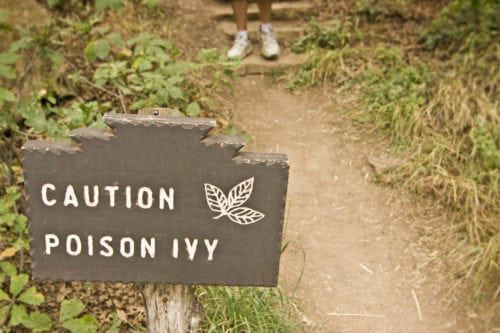
Poison ivy leaves are deciduous and trifoliate – with three almond-shaped leaflets. Thus the saying – Leaves of Three – Let it Be! But of course the running joke in forestry camp was to pull off two of the five leaflets off a Virginia creeper leaf and put it in the front of the face of a newbie and ask him what it was, startling him thinking it was poison ivy. There is nothing like responsible mentoring. Other sayings to avoid the plant include Hairy Vine – No Friend of Mine, or Berries White – Run in Fright.
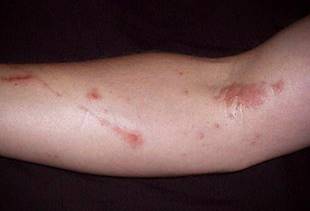
oison ivy leaf edges are smooth while poison oak edges are wavy, resembling an oak leaf. The plant is not a true ivy but is in the same plant family as cashews and pistachios (Anacardiaceae). It can grow as a vine form up the trunk of trees and on fences. The plants flower from May through June and the berry-like fruit matures to a gray-white color in late summer – early fall. The fruits are eaten by a variety of animals and the seeds are spread after passing through their digestive system.
Rhus is the Latin for sumac and radicans is Latin for spreading roots. Diversiloba – varied leaf shape.
Deer, ground squirrels, a variety of birds and other animals are known to eat poison ivy and oak with no reaction to urushiol. Neither native animals, horses, livestock, or canine pets demonstrate reactions either. Interestingly, if your Rover has wandered around a patch of poison oak or ivy and comes into the house – you may get a reaction from any oils accumulated on his fur.
There is some speculation that urushiol evolved as an antimicrobial defense agent, protecting the plant against infection, but not as a defense against people.
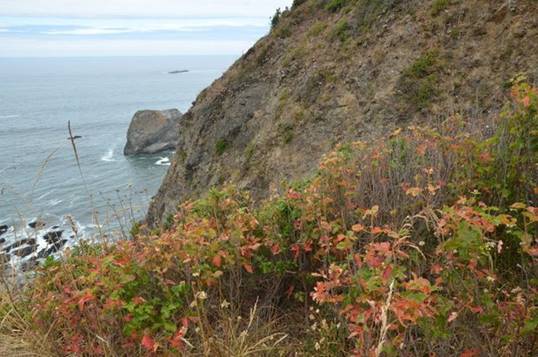
Considering I’ve been around poison ivy and oak quite a bit I’ve had one very minor reaction on one finger – and that was only one time. It seemed to be more prevalent in areas on the east coast where I’ve seen it.
Once I was out for a long summer run on the border of Maryland and West Virginia where I lived. It was rolling hill country – mostly forested Appalachia with scattered farms. Out from home about 5 miles I had to, well, take a break, so headed into the woods. After that business was complete I paused before walking out and noticed I had inadvertently wandered into a huge patch of poison ivy about waist high. Ackkkk!
It was summer and I had no shirt on so keeping my arms high I tip-toed (like that was going to help) out of the 50 ft. long patch back to the road. Being a long way from home I figured that this was the going to be the poison ivy sensitivity test. And luckily I ended up with zero effects. Whew!
